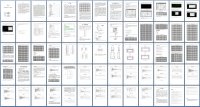矩形高墩地震响应分析(带连系梁)

矩形高墩地震响应分析(带连系梁)(任务书,开题报告,外文翻译,论文说明书13500字)
摘要
随着交通事业的科学技术的发展,越来越多的桥梁需要跨越河谷与深沟,在这种复杂的地形条件下,采用高墩往往能式桥梁更加经济合理。我国是一个地震频繁且分布范围广的国家,在这种大环境下,对于桥梁高墩的抗震响应分析就变得迫切和必要。OpenSEES是目前非常有效的有限元软件,它适用于动力问题的分析求解。本文采用有限元思想,将要分析的梁柱结构离散化,采用Kent-Park混凝土本构模型和Giuffré-Menegotto-Pinto钢筋模型建立桥墩有限元分析计算模型。对结构进行时程分析时,通过调整地震幅值加速度值来得出不同强度地震作用下整个地震作用时程内桥墩墩顶位移、墩底反力与弯矩和墩截面应力应变的变化情况,为空心薄壁箱型桥墩的地震响应分析和桥梁抗震设计概念体系的进一步完善提供参考。主要工作以及得出的相关结论如下:
1)阐述了高墩桥梁的经济适用型和在我国的建设状况,查询相关文献和资料,总结出桥墩地震响应分析的国内外研究现状;
2)学习有限元相关知识,借助有限元软件ETABS建立纤维模型,使用ETO修改模型并生成OpenSEES命令流,修正命令流中节点和单元的定义、约束信息、材料模型、截面信息、重力计算、荷载信息、分析参数设置、数据记录设置等信息。 [资料来源:https://www.doc163.com]
3)根据抗震设计细则确定分析对象的设计地震加速度,分析桥墩在E1地震(多遇地震)、E2地震(罕遇地震)和破坏地震下的结构响应,破坏地震作用即桥墩截面最外缘混凝土的压应力达到抗压强度设计值所对应的地震作用,这三种地震具有不同大小的强度。选用EL-Centro地震波,通过调整地震波加速度幅值来改变地震波的强度大小,运行计算,得出桥墩地震响应(墩顶位移、墩底反力和弯矩、墩截面应力应变)。
关键词:桥梁高墩;OpenSEES;有限元模型;时程分析
Abstract
With the development of science and technology of the transportation, more and more bridges need to be built over the valley and deep groove.In such complex terrain conditions,using high piers could make the bridge more economic and reasonable.China is a country with frequent earthquake of a wide distribution,then it becomes urgent and necessary to ananlyzethe seismic response of the bridge with high piers.OpenSEES is a very effective finite element software,which can be applied to the analysis of dynamic problems.In this thesis,the finite element theory was used to disperse the beam-column structure that has to be analyzed,and the finite element analysis and calculation model of the bridge pier was created withthe Kent-Park Concrete constitutive model and the Giuffre-Menegotto-Pinto steer bar model。For the structure dynamic analysis,the changes Under earthquake with different intensity of the displacement at the top pier,the counter force and bending moment at the bottom pier,and the stress and strain at the pier section in the whole time history of earthquake action were recorded by adjusting the earthquake acceleration amplitude values.It will benefit the Seismic response analysis of the concrete-filled thin-walled steel box piers and further improvement of the concept system of seismic design of bridges. the main research work is as follows: [资料来源:http://doc163.com]
1)This paper describes the economic application of bridge with high pier and the construction in our country.the author inquires the related literature and date,and summarizes the research status of the seismic response analysis of bridge with high piers at home and abroad.
2) The author studys about the konwledge the finite element,creates the fiber model with the finite element software ETABS,and modifies the model to generate the OpenSEES command in ETO.And such information of the command needs to be explained: the definition of node and unit,the constraint,the material model,the section information,the calculation of gravity,the load information,the parameter ananlysis settings,the record of the data,and so on.
3) The autor determines the correct time history process,and analyses the response of the pier in E1 earthquake(frequently occurred earthquake),E2earthquake(rarely occurred earthquake),and destructive earthquake,which have different sizes of strength.the author adopts EL-Centro seismic wave as the load,and changes the intensity of the seismic wave by adjusting the acceleration amplitude of the Seismic wave.Running calculation and get the seismic response of the pier.( the displacement at the top pier,the counter force and bending moment at the bottom pier,the stress and strain at the pier section)
Keywords :bridge with high piers,OpenSEES,finite element model,time history analysis


目录
第一章绪论 7
1.1 研究背景 7
1.2 国内外的研究现状 7
1.3 研究内容和技术方案 9
第二章有限元软件opensees学习 10
2.1 OpenSEES基本介绍 10
2.2 ETABS建模实例学习 11
2.3 ETO程序介绍 16
第三章建立桥墩有限元模型 21
3.1 定义材料 21
3.1.1 混凝土 21
3.1.2 钢筋 23 [来源:http://Doc163.com]
3.2 定义节点 24
3.2.1 梁的节点 24
3.2.2 墩柱的节点 24
3.3 定义单元 26
3.3.1 梁单元 26
3.3.2 墩柱单元 29
3.4 截面的定义 31
3.4.1 梁截面 31
3.4.2 墩截面的定义 32
3.5 截面配筋 32
3.6 梁与墩的重力计算 39
3.7 恒载作用下结构的响应 42
第四章矩形高墩地震响应分析过程 43
4.1 时程分析原理 44
4.2 地震波的选取 44
4.3 E1地震作用和E2地震作用下的结构响应 45
4.4 破坏地震作用下的结构响应 58
第五章结论与展望 65
5.1 本文主要结论 65
5.2 研究展望 65
参考文献 66
致谢 67
